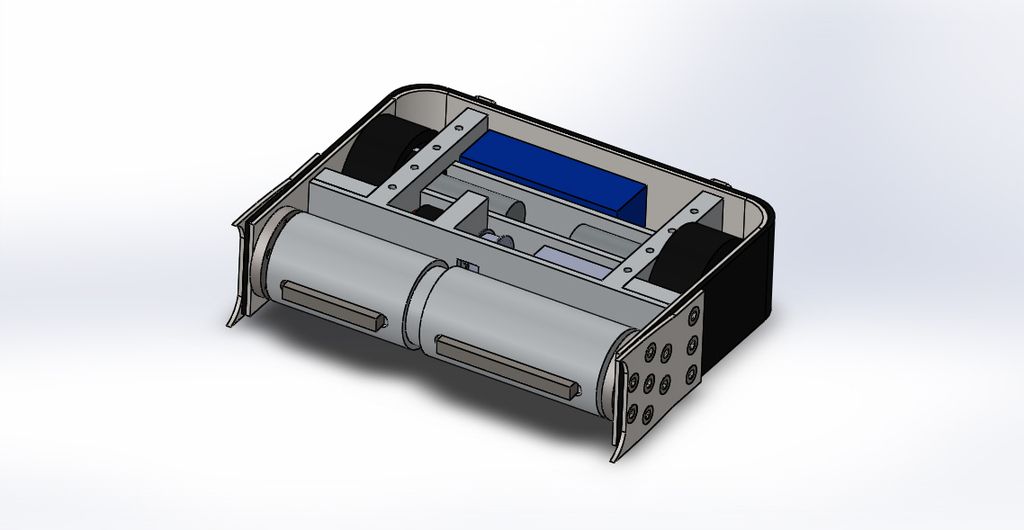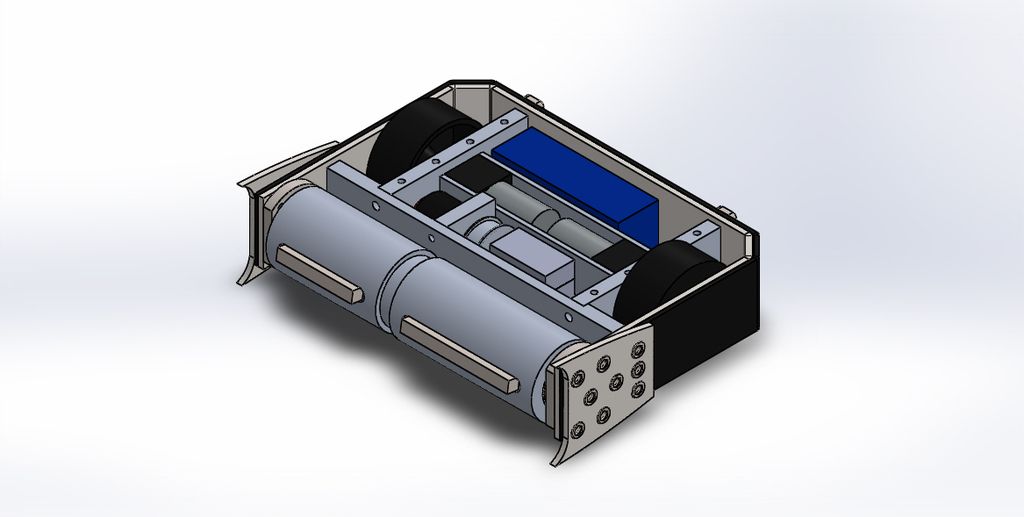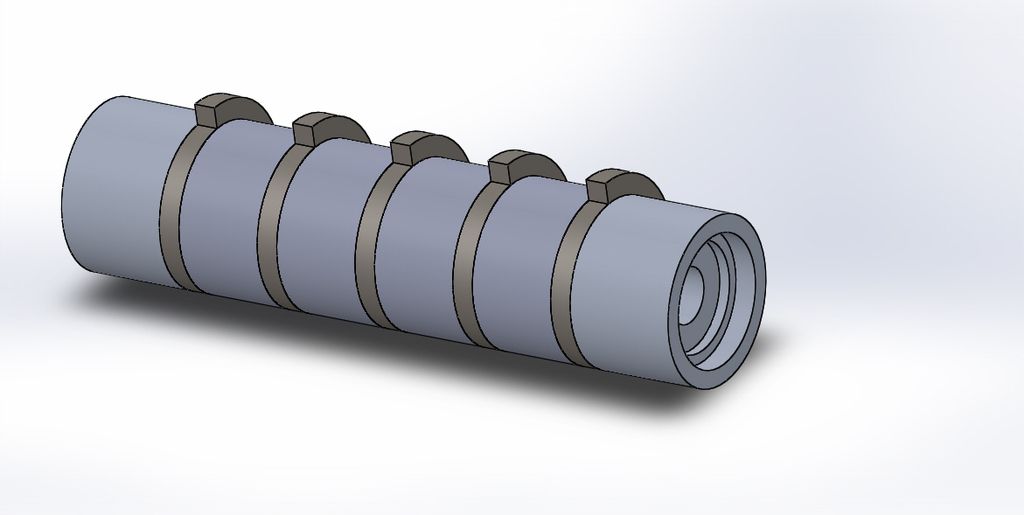I'll have GR02's for sale soonish, send me a PM, we can sort out a price. I will ensure Ellis doesn't lose a sale by purchasing a couple of extra sets of his  btw your bulkhead is too thin
btw your bulkhead is too thin 
Announcement
Collapse
No announcement yet.
Team MedBots
Collapse
X
-
Ok, I'll send you a pm.Originally posted by Gabe01 View PostI'll have GR02's for sale soonish, send me a PM, we can sort out a price. I will ensure Ellis doesn't lose a sale by purchasing a couple of extra sets of his btw your bulkhead is too thin
btw your bulkhead is too thin 
Latest CAD:

All Hardox is now 4mm but I have extended those front pieces back to offer more support to the drum. The front thin bulkhead is perhaps a bit thin, I'll see if I can find the weight to thicken it up a bit.
Comment
-
The front bulkhead doesn't need to be that thick, just as long as it doesn't flex much. I think Dave uses 1.6mm or 2mm ti on 720 without issue. I used 5mm ali on Drumroll and there are two gouges on it from the drum teeth, where it bent outwards towards the weapon after an impact. Was essentially hammering it flat again after every fight.
Comment
-
Thank to Ellis' brilliant suggestion of making it less tall I have made an entirely new CAD model:

It may well look exactly the same but in fact it is now only 60mm high and by down grading the motors from 775s to 550s I no longer need to have the gearbox sitting inside the wheels so the bulkheads don't have to have a massive 40mm square hole in them for the gearbox. By converting to metric it has also allowed be to slim down the bulkheads to 15mm rather than 3/4" and the fron bulk head has gone up from 1/4" to 10mm. All of this has saved tonnes of weight so all the Hardox has gone back to 6mm and it still had the 4mm HDPE around the outside for added protection though I may thicken this to maybe 10mm. Depending on the wall thickness of the drum there can be just enough weight for a 4mm Hardox top and bottom, though they may need a few holes in them. For now I'll use 6mm polycarbonate and see how the weight is doing.
First job is to make the outer armour so I will send this off the waterjet cutters soon. One thing I am curious about is what do people think about the fron end? Are the little 'wedgelets' going to get bent up as soon as I hit a joint in the floor?Last edited by Max; 22 June 2015, 21:51.
Comment
-
A CAD animation to show the drum spinning from the side of the robot:
https://youtu.be/_GNU-DGZtZY
I'm still concerned about those wedges getting bent too easily by the floor/other robots and am not sure if perhaps they will get in the way of attacking other robots, but also think I will need them to get under other wedges to bring them up into the path of the drum. What do you guys think?
Comment
-
Whilst I'm waiting for parts to show up for the feather weight I've been working on the heavyweight.
Finally a full pressure pneumatics test:
http://youtu.be/nQHECcujhFk
Anyone got any advice on how to stop the bushing coming out the end?
Next step is to do the wiring with a decent removable link so I can have it driving around (last time the main power wires melted!)
Then just need to sort out a flipper arm and finish off the chassis, might see if I can switch to a front hinge as I think that would put less stress on the piston rod.
Comment
-
You will need an even number of disks to make it balanced with half the teeth on one side and half on the other; I would go with Matt's suggestion of thicker teeth and smaller spacers. Having a sandwich of teeth and spacers reduces strength and stiffness; the axle is the main part keeping everything straight so it needs to be really strong.
Comment
-
The whole drum would be slightly in compression holding it together. The bearings are set into the end of each drum so there would be a small axial load on the bearings.
The other thing is didn't mention was that the teeth would be made of some form of steel and the spacers aluminium, so weight becomes an issue as the teeth get wider! As it stands it shoud I be about 3kg
Comment
-
What is applying the tension? If you are compressing the drum via the bearings, you will need tapered roller bearings; ball bearings will wear quickly. The problem with this is that tensioning bearings too much really increases their rolling resistance, so you will be wasting power overcoming bearing friction, which will be dumped as heat in the bearings. Sorry to be blunt, but my gut feeling is that this design will bend and fail after an impact with another vertical spinner.
I'm guessing this design is to allow teeth to be replaced as they wear, which is a good idea. If that is what you are after, I would go for the same design as 720's aluminium drum. It is probably no harder to make and removes all the structural problems, plus that design is field-tested and proven reliable. Mouldy made the aluminium body of the drum really thick, but you can always reduce the weight with a larger bore.
Comment
-
I guess the 4 rods running through it could be threaded at the end with counterbored nuts at the end to compress the whole thing together, maybe I could redesign the spacers and the disks so they sort of slide over each other/interlock to improve stiffness of the system.
The idea behind the system is to be more easy to repair/replace sections and to overcome the problems Mouldy had early on with the teeth ripping out (he had to dovetail the teeth in or something I beleive)
Comment
-
Mouldy used a T slot to hold the teeth in, as least on the drum that I saw. The nice thing about that is the teeth slide right out once the end of the drum is removed.
Using the rods to hold the drum together will definitely improve the stiffness but its going to need CNC accuracy to get everything aligned.
Comment



Comment